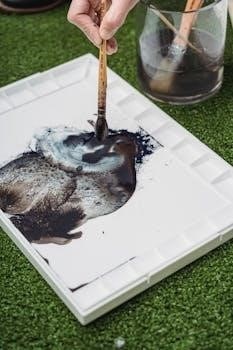generac 2900 psi pressure washer manual
Category : Manuals
The Generac 2900 PSI pressure washer is a powerful tool designed for efficient outdoor cleaning. This unit offers a combination of cleaning power, reliability and user-friendly design. It is a compact and affordable solution for various tasks, from patio furniture to driveways.
Overview of the Generac 2900 PSI Model
The Generac 2900 PSI pressure washer is engineered to provide robust cleaning capabilities for residential use. This model is designed with user convenience and durability in mind, making it suitable for a variety of outdoor cleaning tasks. It features a powerful engine and an axial cam pump, ensuring reliable performance and consistent water flow. The unit is built on a welded steel frame, which provides stability during operation and enhances its longevity. Its compact design makes it easy to move and store. The Generac 2900 PSI model is known for its ease of use, with user-friendly controls and a comfortable handle for enhanced maneuverability. The machine operates at a maximum pressure of 2900 PSI and a flow rate of up to 2.5 gallons per minute, making it effective for removing dirt, grime, and mildew from various surfaces. This model often includes features like an automatic cool-down system and quick-connect nozzles for added convenience. It is an ideal choice for homeowners seeking a powerful and reliable pressure washer.

Key Features and Specifications
This section details the core features and specifications of the Generac 2900 PSI pressure washer. We will cover the pressure, flow rate, engine, pump, nozzle and hose details.
Maximum Pressure and Flow Rate
The Generac 2900 PSI pressure washer is engineered to deliver a robust cleaning performance, boasting a maximum pressure of 2900 pounds per square inch (PSI). This high-pressure output is crucial for effectively removing stubborn dirt, grime, and mildew from various surfaces. The unit also provides a consistent flow rate, typically around 2.4 to 2.5 gallons per minute (GPM), ensuring a steady stream of water for thorough cleaning. This combination of high pressure and a decent flow rate allows users to complete cleaning tasks efficiently. The 2900 PSI pressure output is particularly useful for tough jobs such as cleaning concrete, decks, and siding. The consistent flow rate helps maintain the cleaning power, preventing any interruptions during the process. These specifications make the Generac 2900 PSI pressure washer a reliable tool for both residential and light-duty commercial cleaning needs, offering a balance of power and efficiency.
Engine and Pump Type
The Generac 2900 PSI pressure washer is powered by a reliable OHV (Overhead Valve) engine, designed to deliver consistent performance for various cleaning tasks. This engine type is known for its durability and efficiency, contributing to the overall longevity of the unit. Paired with the engine is an axial cam pump, a common choice in residential pressure washers. The axial cam pump features stainless steel pistons, enhancing its durability and resistance to wear and tear. This pump is designed to provide a steady and reliable flow of water at the specified pressure. The combination of the OHV engine and the axial cam pump ensures that the Generac 2900 PSI pressure washer delivers the necessary power and reliability for effective cleaning. The axial cam pump is also relatively low-maintenance, further adding to the user-friendliness of the unit. This pairing makes the Generac 2900 PSI a suitable choice for consumers looking for a dependable and long-lasting pressure washer.
Nozzle and Hose Details
The Generac 2900 PSI pressure washer comes equipped with a variety of quick-connect nozzles, allowing users to easily switch between different spray patterns for various cleaning applications. These nozzles include options for narrow, high-pressure streams and wider, lower-pressure sprays, providing versatility for different cleaning tasks. Additionally, the unit features a turbo nozzle, which enhances cleaning power by creating a rotating, high-pressure jet. The 25-foot high-pressure hose provides ample reach and flexibility when cleaning hard-to-reach areas. The hose is designed to be kink-resistant and non-marring, ensuring durability and preventing damage to surfaces. The quick-connect fittings on both the hose and nozzles make setup and switching between attachments quick and easy. The nozzle extension with quick-connect fitting further enhances the user experience, allowing for comfortable cleaning and greater reach, making the Generac 2900 PSI user-friendly.

Manual and Documentation Resources
User manuals, parts lists, and spec sheets for the Generac 2900 PSI pressure washer can be found on Generac’s website. These resources are essential for proper maintenance and safe use.
Locating the User Manual
To locate the user manual for your Generac 2900 PSI pressure washer, start by visiting the official Generac website. Navigate to the product lookup page, where you can enter your pressure washer’s model or serial number. This will allow you to access specific documentation related to your unit. The manuals are typically available in PDF format, making them easy to download and view on various devices. Additionally, these online resources often include not only the main user manual, but also quick start guides, parts lists, and spec sheets. If you have questions, Generac’s customer service can be reached via phone or their website. Furthermore, third-party websites like Manuals.ca also offer access to the Generac 2900PSI manual, ensuring you have multiple avenues for finding the necessary documentation for your pressure washer. The user manual is essential for understanding your pressure washer’s operation, maintenance, and safety procedures.
Language Availability of Manuals
The primary language for the Generac 2900 PSI pressure washer user manual is English. This ensures that the majority of users can easily understand the operating instructions, safety guidelines, and maintenance procedures. While English is the main language, it is important to note that Generac may also provide manuals in other languages depending on the region and distribution. If you require a manual in a language other than English, it’s best to check the Generac website or contact their customer service. Third-party websites that offer manuals, such as Manuals.ca, also specify the language options available. It’s crucial to use a manual in a language you fully understand to ensure safe and effective operation of your pressure washer. The availability of manuals in different languages can also be beneficial for users who are more comfortable with a language other than English.

Usage and Applications
The Generac 2900 PSI pressure washer is suitable for a wide array of cleaning tasks including patios, driveways, decks, and vehicles. Its high pressure output effectively removes dirt, grime, and mildew from various surfaces.
Suitable Cleaning Tasks
The Generac 2900 PSI pressure washer is exceptionally versatile, making it ideal for a wide range of outdoor cleaning applications. It can efficiently tackle tasks such as cleaning driveways, removing stubborn stains and grime from concrete surfaces, and revitalizing patios and decks. The powerful water pressure is also effective for cleaning siding, removing dirt, mold, and mildew, ensuring your home’s exterior looks its best. This pressure washer is also well-suited for cleaning vehicles, including cars, trucks, and motorcycles, providing a thorough and efficient wash. Furthermore, it can be used to clean outdoor furniture, removing dirt and debris, and preparing them for use. The Generac 2900 PSI is perfect for a variety of tasks, from light duty cleaning to tackling tough grime. Its power and flexibility make it a valuable tool for maintaining your property’s cleanliness and appearance.

Ease of Use and Design Features
The Generac 2900 PSI pressure washer is designed with user convenience in mind, making it easy to operate and maneuver. Its user-friendly design allows for simple assembly and hose connection, ensuring a quick setup process. The machine’s compact and lightweight structure enhances portability, allowing you to move it around with ease, regardless of the terrain. The inclusion of an inverted trigger with a cushion grip adds to the comfort of extended use, reducing fatigue during longer cleaning sessions. The integrated spray gun holder keeps the spray gun secure during transport and storage, preventing damage. Additionally, the pressure washer features a 25-foot high-pressure flex hose, providing added reach and flexibility for cleaning hard-to-reach areas. The welded steel frame offers stability and durability, ensuring the machine can withstand the rigors of outdoor use. These design features collectively make the Generac 2900 PSI pressure washer user-friendly and efficient.



































